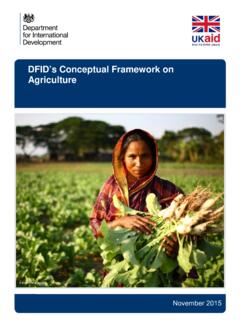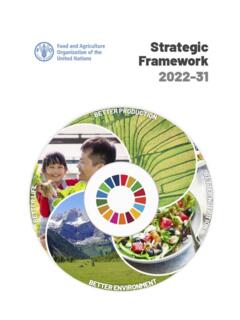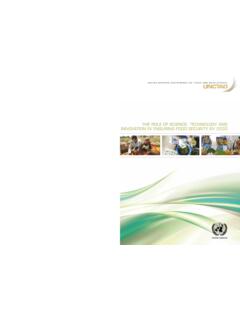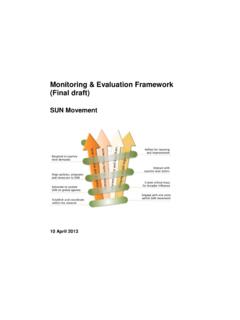Transcription of Global Strategic Framework for Food Security & Nutrition …
1 Committee on World food Security (CFS) Global Strategic Framework for food Security & Nutrition (GSF) Third Version 2014 2 TA B L E OF C ON TE N TS CHAPTER I: INTRODUCTION AND BACKGROUND .. 5 A The reform of the Committee on World food Security , its vision and 5 B Nature, purpose, and process of elaboration of the GSF .. 6 C Definitions .. 7 CHAPTER II: THE ROOT CAUSES OF HUNGER, LESSONS LEARNED, AND EMERGING CHALLENGES .. 8 A Structural causes of hunger and malnutrition .. 8 B Past experiences and lessons learned .. 9 C Emerging challenges and looking ahead .. 11 CHAPTER III: THE FOUNDATIONS AND OVERARCHING FRAMEWORKS .. 12 A The Millennium Development Goals (MDGs) .. 12 B The Voluntary Guidelines to support the progressive realization of the right to adequate food in the context of national food Security (VGRtF).
2 12 C The Five Rome Principles for Sustainable Global food Security .. 12 D The Voluntary Guidelines on the Responsible Governance of Tenure of Land, Fisheries and Forests in the Context of National food Security (VGGT).. 13 E High-Level Forums on Aid Effectiveness: .. 13 F United Nations Updated Comprehensive Framework for Action (UCFA) .. 14 G Other frameworks and documents .. 14 food Security exists when all people, at all times, have physical, social and economic access to sufficient, safe and nutritious food that meets their dietary needs and food preferences for an active and healthy life. The four pillars of food Security are availability, access, utilization and stability. The nutritional dimension is integral to the concept of food Security and to the work of CFS (CFS Reform Document 2009).
3 3 CHAPTER IV: POLICY, PROGRAMME, AND OTHER RECOMMENDATIONS .. 15 A The twin-track approach .. 15 B Increasing smallholder-sensitive investment in agriculture .. 16 Mozambique: UN agencies combine efforts to help farmers .. 18 C Addressing excessive food price volatility .. 18 What is AMIS? .. 21 D Addressing gender issues in food Security and Nutrition .. 21 Improving women s access to finance in Yemen .. 23 E Increasing agricultural productivity and production in a socially, economically and environmentally sustainable manner .. 23 F Nutrition .. 25 THE REACH ENDING CHILD HUNGER AND UNDER Nutrition INITIATIVE: THE CASE OF BANGLADESH .. 27 G Tenure of land, fisheries and forests .. 27 GOVERNANCE OF TENURE OF LAND, FISHERIES AND FORESTS .. 29 H Addressing food Security and Nutrition in Protracted Crises.
4 30 I Social ProTection for food Security and Nutrition .. 31 J food Security and Climate Change .. 34 K Biofuels and food L Investing in Smallholder Agriculture for food Security and CHAPTER V: UNITING AND ORGANIZING TO FIGHT HUNGER .. 43 A Core actions at country level .. 43 Brazil a success story in institutionalizing multi-ministerial coordination and civil society participation to address food insecurity and promote the right to food .. 45 B Improving regional support to national and local actions .. 46 THE COMPREHENSIVE AFRICA AGRICULTURE DEVELOPMENT PROGRAMME (CAADP) .. 47 C Improving Global support to regional and national actions, and response to Global challenges .. 48 D Making it happen: linking policies and programmes with resources .. 50 THE Global AGRICULTURE AND food Security PROGRAMME (GAFSP).
5 52 E Monitoring and follow-up .. 52 4 CHAPTER VI: ISSUES THAT MAY REQUIRE FURTHER ATTENTION .. 56 ABBREVIATIONS .. 57 ENDNOTES .. 59 5 C HA P TER I: I N TR ODU C T I ON A N D B A CK GR OU N D For the period 2011-2013, a total of 842 million people or around one in eight people in the world were estimated to be suffering from chronic hunger, which means that they are not getting enough food to conduct an active life1. The food crisis of 2007 08, followed by the financial and economic crisis in 2009, continuing in 2012, drew stark attention to the daily challenges faced by millions of families around the world in their attempt to overcome hunger and poverty and seek stable livelihoods that support a just and dignified way of Despite the efforts of many, and the commitment of the international community in the Millennium Declaration to reduce by half the proportion of people who suffer from hunger by 2015, persistent hunger and malnutrition remains the norm for millions of human beings.
6 A THE REFORM OF TH E COMMITTEE ON W ORLD FO OD SEC UR ITY, ITS VIS IO N AND R OLES Faced with rising hunger and fragmented governance for food Security and Nutrition , Member States of the Committee on World food Security (CFS) agreed at the Committee s 34th Session in October 2008 to embark on an ambitious reform. The CFS Reform, endorsed by all CFS Member States in 20093, redefines the CFS vision and roles, aiming at constituting the foremost inclusive international and intergovernmental platform for a broad range of committed stakeholders to work together in a coordinated manner and in support of country-led processes towards the elimination of hunger and ensuring food Security and Nutrition for all human beings . CFS Membership is open to all Member States of FAO, WFP or IFAD, or non-member States of FAO that are Member States of the United Nations, and its Participants include: representatives of UN Agencies and bodies with a specific mandate in the field of food Security and Nutrition ; civil society and non-governmental organizations and their networks; international agricultural research systems; international and regional financial institutions; and representatives of private-sector associations and private philanthropic foundations.
7 The decisions of the CFS are adopted on the basis of consensus among Member States, who have sole voting rights. The vision of the reformed CFS is to strive for a world free from hunger where countries implement the voluntary guidelines for the progressive realization of the right to adequate food in the context of national food Security .4 The main roles for the CFS, to be implemented gradually, are defined as providing a platform to promote better coordination at Global , regional and national levels; promote policy convergence; facilitate support and advice to countries and regions; and promote accountability and share best practices at all levels5. CFS debate and decision-making are supported with structured expertise through the creation of a High Level Panel of Experts (HLPE) so that the decisions and recommendations of the CFS are based on hard evidence and state of the art knowledge.
8 The FAO Conference instituted the CFS as a Committee hosted in FAO, with a Joint Secretariat composed by FAO, IFAD and WFP. Non-governmental actors were called to organize themselves autonomously in order to facilitate their interaction and engagement with the Committee, which led to the creation of the Civil Society Mechanism (CSM) and Private Sector Mechanism. At the same time, several countries and regional organizations and mechanisms are actively debating ways to deepen their engagement in and links to the CFS s initiatives and deliberations. 6 B NATU RE, PURP OSE, AND PR OCESS OF ELAB ORA T IO N OF THE GSF This Global Strategic Framework for food Security and Nutrition (GSF) is a single, living document to be approved by the CFS Plenary. Its purpose is to improve coordination and guide synchronized action by a wide range of stakeholders.
9 The GSF will be flexible so that it can be adjusted as priorities change. The main added value of the GSF is to provide an overarching Framework and a single reference document with practical guidance on core recommendations for food Security and Nutrition strategies, policies and actions validated by the wide ownership, participation and consultation afforded by the CFS. The GSF is not a legally binding instrument. It offers guidelines and recommendations for catalysing coherent action at the Global , regional and country levels by the full range of stakeholders, while emphasizing the primary responsibility of governments and the central role of country ownership of programmes to combat food insecurity and malnutrition. The GSF emphasizes policy coherence and is addressed to decision- and policy-makers responsible for policy areas with a direct or indirect impact on food Security and Nutrition , such as trade, agriculture, health, environment, natural resources and economic or investment policies.
10 These guidelines and recommendations should be interpreted and applied in accordance with national policies, legal systems and institutions. The GSF should also be an important tool to inform the actions of policy-makers and decision-makers, development partners, cooperation and humanitarian agencies, as well as international and regional organizations, financial institutions, research institutions, civil society organizations (CSOs), the private sector, NGOs, and all other relevant stakeholders acting in the food Security and Nutrition fields at Global , regional and country levels. The GSF consolidates relevant recommendations adopted by the CFS Plenary and takes into account other existing frameworks, guidelines and coordination processes at all levels; country-level experience and stocktaking; best practices, lessons learned and evidence-based knowledge.














